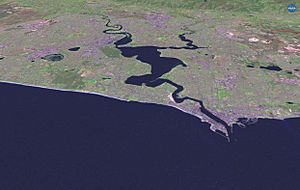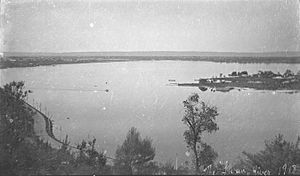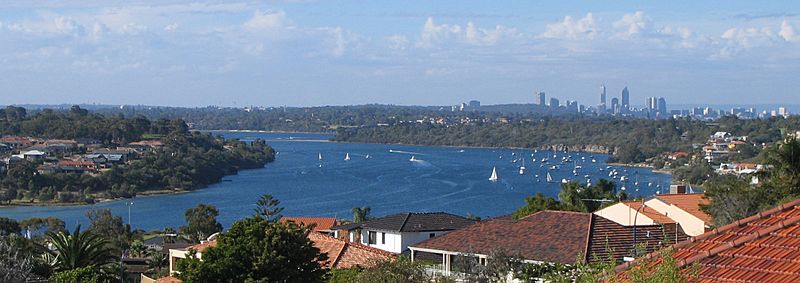Swan River facts for kids
Quick facts for kids Swan River |
|
|---|---|
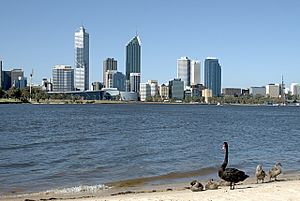
|
|
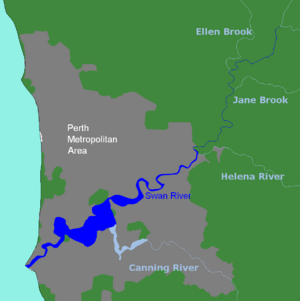
Map of the area around Perth, showing the location of the Swan River
|
|
| Native name | Noongar: Derbarl Yerrigan |
| Country | Australia |
| State | Western Australia |
| City | Perth; Fremantle |
| Physical characteristics | |
| River mouth | Indian Ocean Fremantle 0 m (0 ft) 32°4′25″S 115°42′52″E / 32.07361°S 115.71444°E |
| Length | 72 km (45 mi) |
| Basin features | |
| Basin size | 121,000 km2 (47,000 sq mi) |
| Tributaries |
|
The Swan River is a famous river in the southwest of Western Australia. Its original Aboriginal name, from the Noongar language, is Derbarl Yerrigan. This important river flows right through Perth, which is the capital and largest city of Western Australia.
Contents
The River's Journey
The Swan River starts as the Avon River. It flows through Perth and then into the Indian Ocean. The part of the river near the ocean is wide and deep. Further upstream, the river becomes narrower and shallower.
The Swan River collects water from a huge area of about 121,000 square kilometres (47,000 sq mi). It has three main rivers that feed into it: the Avon River, the Canning River, and the Helena River. The Canning and Helena rivers have dams that help supply drinking water to Perth. The Avon River brings most of the fresh water into the Swan. The area has a Mediterranean climate, meaning it has mild, wet winters and hot, dry summers. This means the river's water levels change a lot with the seasons.
The Avon River begins near Yealering, about 221 kilometres (137 mi) southeast of Perth. It winds its way north to Toodyay. Then, in Walyunga National Park, it meets Wooroloo Brook and officially becomes the Swan River.
The Canning River starts near North Bannister, about 100 kilometres (62 mi) southeast of Perth. It joins the Swan River at Applecross. From there, the river gets narrower and deeper, flowing through Fremantle Harbour and out to the Indian Ocean.
The Wagyl Story
The Noongar people have a special belief about the river. They say that the Darling Scarp (a line of hills) is the body of a Wagyl. The Wagyl is a snake-like creature from their Dreamtime stories. It is believed that the Wagyl moved across the land, creating all the rivers, waterways, and lakes, including the Swan River.
River Features and Surroundings
The Swan River flows across the Swan Coastal Plain. This area has a Mediterranean climate, with hot, dry summers and cool, wet winters. The river starts in the Darling Scarp hills and flows downhill to the ocean at Fremantle.
River Branches
Many smaller streams, called tributaries, join the Swan River. These include Ellen Brook, Jane Brook, and the Helena River. However, many of these streams now dry up or only flow during certain seasons. This is because of human activities like clearing land and building new areas.
Wetlands and Islands
Between Perth and Guildford, the river makes several loops. In the past, many areas like Maylands Peninsula and Ascot were swampy wetlands. Most of these wetlands have been filled in for building. Heirisson Island, where The Causeway bridge crosses, used to be a group of small islands.
Perth Water and Melville Water
Perth Water is the part of the river between the city and South Perth. It is separated from the main river by "The Narrows," where the Narrows Bridge was built. The river then opens up into a large area called Melville Water. The Canning River joins the Swan here. This is the widest part of the river, over 4 kilometres (2.5 mi) across.
Towards the Ocean
The river narrows again between Chidley Point and Blackwall Reach. It then flows into Fremantle Harbour. The Stirling Bridge and the Fremantle Traffic Bridge cross the river just before it reaches the ocean. The Swan River finally empties into the Indian Ocean at Fremantle Harbour.
Interesting Spots Along the River
- Fremantle Harbour
- Point Brown
- Rous Head
- Arthur Head
- Victoria Quay
- Point Direction
- Preston Point
- Rocky Bay
- Point Roe
- Chidley Point
- Blackwall Reach
- Butler's Hump
- Point Walter
- Mosman Bay
- Keanes Point
- Freshwater Bay
- Point Resolution
- Melville Water
- Lucky Bay
- Point Waylen
- Alfred Cove
- Point Dundas
- Waylen Bay
- Point Heathcote
- Quarry Point
- Mounts Bay
- Point Lewis
- Mill Point
- Point Belches
- Elizabeth Quay
- Pelican Point
- Matilda Bay
- The Narrows
- Perth Water
- Point Fraser
- Heirisson Island
- Claise Brook
- Maylands Peninsula
- Ron Courtney Island
- Swan Valley
- Kuljak Island
Plants and Animals of the Swan River
The Swan-Canning Estuary is home to many different plants and animals. Here are some of them:
- Fish: Over 130 types of fish live here, including bull sharks, rays, cobblers (also called Swan River catfish), herring, pilchards, bream, flatheads, leatherjackets, and blowfish.
- Jellyfish: You can find jellyfish like Phyllorhiza punctata and Aurelia aurita.
- Dolphins: Bottlenose dolphins are often seen swimming in the river.
- Crabs and Prawns: Look out for prawns and blue manna crabs.
- Birds: Many birds live near the river, including the famous black swan, silver gulls, cormorants, twenty-eight parrots, rainbow lorikeets, kingfishers, red-tailed black cockatoos, Australian pelicans, Australian magpies, herons, and ducks.
History of the Swan River
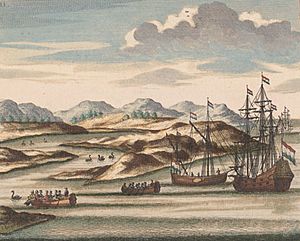
The river was named Swarte Swaene-Revier (Black Swan River) by Dutch explorer Willem de Vlamingh in 1697. He named it after the many black swans he saw there. Vlamingh sailed up the river to around Heirisson Island.
Another explorer, Nicholas Baudin from France, also explored the river in 1801.
When the city of Perth was started in 1829, people began to change the river. They did this for several reasons:
- To stop flooding in winter.
- To make it easier for boats to travel by making channels deeper.
- To get rid of swampy areas that attracted mosquitoes.
- To create more dry land for farming and building.
Early Perth streets were often very sandy. Governor James Stirling noted in 1837 that there were hardly any proper roads. People had to cross the river using ferries.
Parts of the river needed to be dredged, which means digging up the bottom. The dug-up material was used to fill in muddy areas and raise the land. A very wet winter in 1862 caused major flooding. This flooding was made worse because so much land had been reclaimed. The first machine used for dredging in Western Australia was called the Black Swan. It worked on the river from 1872 to 1911.
Changes to the River
Since European settlement in 1829, many parts of the river have been changed:
- Claise Brook: This used to be a freshwater creek. For many years, it was used to dump waste into the river. Today, the area has been cleaned up and is mostly residential.
- Point Fraser: This was a large piece of land on the northern side of the river. It was filled in between 1921 and 1935 to make the riverbank straighter.
- The Esplanade: The northern riverbank used to be much closer to the city. More land was added to create the Esplanade road.
- Heirisson Islands: These were once several small mudflats. Now, there is one larger, man-made island with deep channels on each side.
- Burswood: A canal was built in 1831 to help boats get past shallow areas. This created Burswood Island. More land was filled in during the 1900s.
- Point Belches (Mill Point): This was a sandy area with a deep bay. It was later filled in to become the South Perth peninsula, where the Narrows Bridge is now.
- Mounts Bay: This bay was made much smaller in the 1950s when the Narrows Bridge was built. An elderly woman, Bessie Rischbieth, famously protested by standing in front of bulldozers in 1957.
- Fremantle Harbour: The harbour was built in the 1890s. A limestone reef that blocked the river's mouth was removed. This changed how the river flowed, making it more affected by tides.
Environmental Challenges
The river has faced problems from pollution. In the past, all kinds of waste were dumped into it. Even in the 1970s, rubbish tips were on the river's edge. Factories also released waste. Cleanup efforts are still happening in some areas to remove harmful chemicals.
In summer, there are often problems with algal blooms. These are caused by too many nutrients from farms and fertilisers washing into the river. Algal blooms can kill fish. Sometimes, sewage or chemicals have accidentally spilled, causing parts of the river to be closed. Despite these challenges, the river is still in pretty good shape.
In 2010, the Western Australian government limited phosphorus in fertilisers. This was to protect the health of the Swan and Canning river system.
The Perth Water area is a popular spot for the annual Australia Day fireworks show. Over 400,000 people gather along the river, in Kings Park, and on boats to watch.

Major Floods
Records of floods in the Swan River go back to 1829. In July 1830, the river rose 6 metres above its normal level! Many new settlers lost their belongings. Other big floods happened in 1847, 1860, and 2017.
The biggest flood recorded was in July 1872. It was so big that it's called a "100-year flood." This means a flood of that size is expected to happen only once every 100 years on average. During this flood, the river looked like a huge lake. All the jetties were underwater, and roads to Fremantle were covered.
The flood of July 1926 caused the Upper Swan Bridge to wash away. A part of the Fremantle Railway Bridge also collapsed. Luckily, no one was hurt when the railway bridge collapsed, even though a train with schoolchildren had just crossed it.
How People Use the River
Getting Around
In the early days of the Swan River Settlement, the river was the main way to travel between Perth and Fremantle. This continued until train lines were built.
Bridges Over the Swan River
There are 22 road and railway bridges that cross the Swan River. Here they are, starting from Fremantle and going upstream:
- Fremantle Railway Bridge, North Fremantle to Fremantle
- Fremantle Traffic Bridge, North Fremantle to Fremantle
- Stirling Bridge (Stirling Highway), North Fremantle to East Fremantle
- Narrows Bridge, South Perth to Perth (three separate bridges for freeway and train)
- The Causeway (north), Perth to Heirisson Island
- The Causeway (south), Heirisson Island to South Perth
- Matagarup Bridge, East Perth to Perth Stadium, Burswood (pedestrian bridge)
- Goongoongup Bridge, East Perth to Burswood (railway line)
- Windan Bridge, East Perth to Burswood, (Graham Farmer Freeway)
- Garratt Road Bridge, Bayswater to Ascot (two separate bridges)
- Redcliffe Bridge, Bayswater to Ascot (Tonkin Highway)
- Bassendean Bridge, Bassendean to Guildford
- Guildford Railway Bridge, Bassendean to Guildford
- Barkers Bridge, Guildford to Caversham
- Whiteman Bridge, Caversham to Middle Swan (Reid Highway and Roe Highway)
- Maali Bridge, Henley Brook to Herne Hill (pedestrian bridge)
- Yagan Bridge, Belhus to Upper Swan (Great Northern Highway)
- Upper Swan railway bridge, Upper Swan (unnamed)
- Bells Rapids bridge, Upper Swan to Brigadoon (unnamed)

Water Sports and Clubs
The Swan River is a popular place for water sports. Many rowing and yacht clubs are located along its banks.
- Rowing Clubs: The first rowing club was the West Australian Rowing Club. The Swan River Rowing Club started in 1887.
- Yacht Clubs: There are fifteen yacht clubs along the river. Most are on Melville Water, Freshwater Bay, and Matilda Bay. The Royal Perth Yacht Club hosted the famous 1987 America's Cup sailing race.
Cultural Importance
The Swan River is a very important part of Perth's culture. For a long time, people in Perth even talked about living "north of the river" or "south of the river." This was because it used to take a long time to cross the river before the main bridges were built.
Today, the river is a hub for many water sports like rowing, sailing, and swimming. It is also the location for the huge City of Perth Skyworks fireworks show every year on Australia Day.



